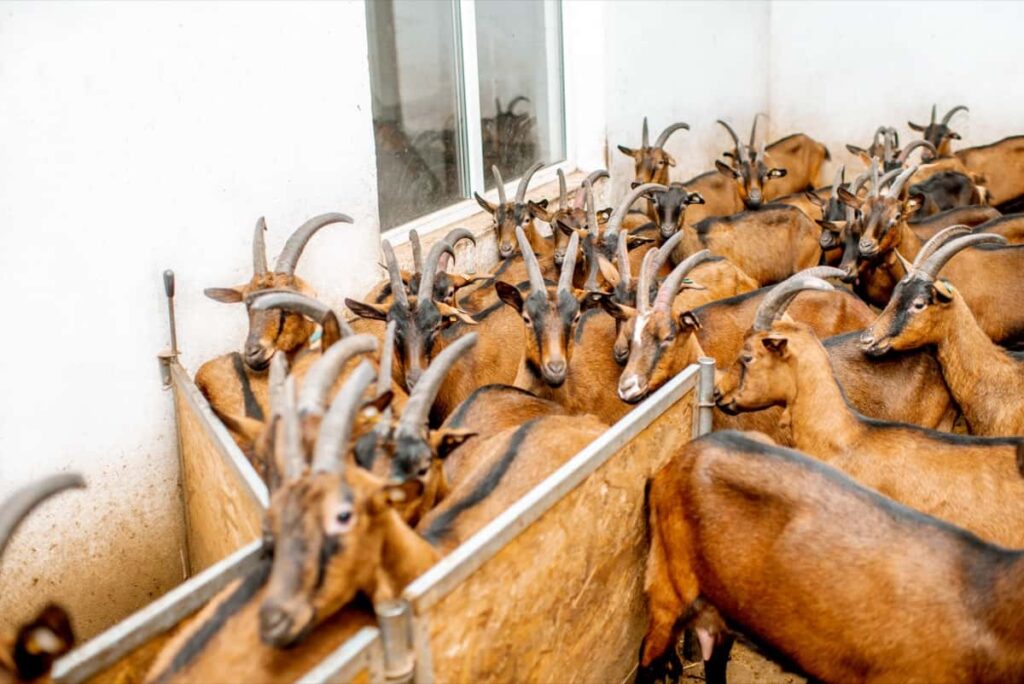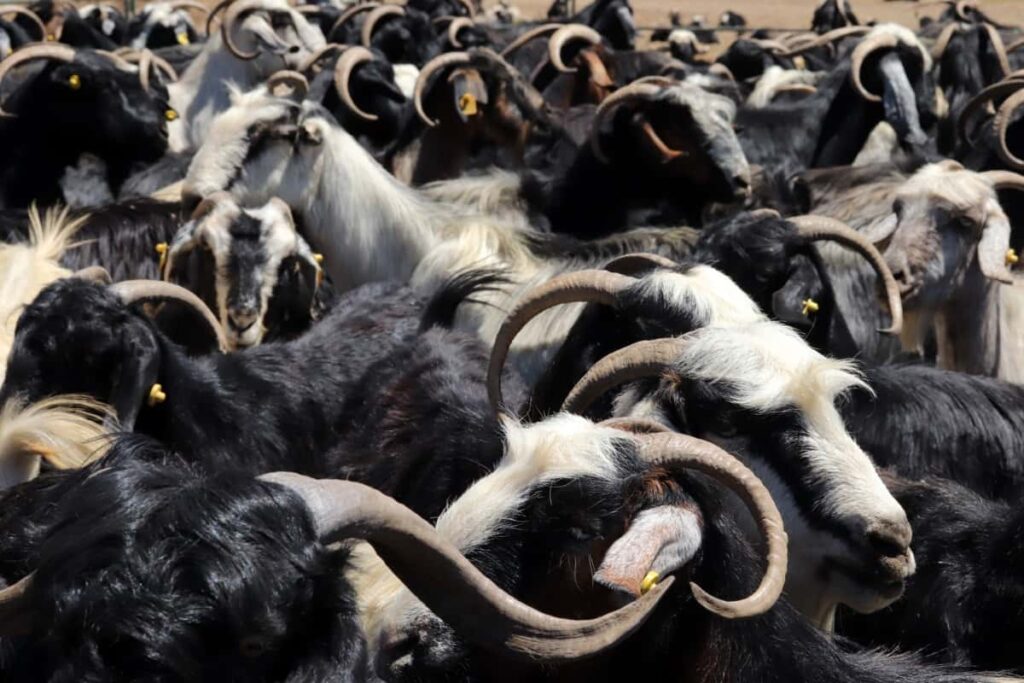Goat farming is an excellent opportunity for entrepreneurs who want to venture into the agricultural industry. Starting a goat farming business plan is an exciting opportunity for individuals interested in agriculture or seeking alternative forms of income.

Goat Farming Business Plan Information
What is Goat Farming?
Goat farming is the practice of rearing and raising goats for milk, meat, wool, or fiber. The industry has become increasingly popular due to its profitability and sustainability. Goat farming involves breeding high-quality goats that meet market demands while ensuring proper care and management. Goats require less space than other livestock, such as cows, and can thrive on low-quality feed.
Different Types of Goat Farms for Successful Business
- There are several types of goat farms that you can start depending on your business goals and interests. One popular type is the dairy goat farm, which produces milk for consumption or processing into cheese, yogurt, and other products.
- Another option is raising goats for meat, which involves breeding and fattening the animals before selling them to local markets or restaurants. Alternatively, a fiber goat farm focuses on producing high-quality wool.
- A grazing operation may be the way for those interested in sustainable agriculture. In this farm system, goats can roam freely and graze on natural vegetation while helping manage pasture weeds.
What Breeds of Goats is Best for a Successful Goat Framing Business?
- Choosing the right breed is crucial for a successful goat farming business. With over 200 different breeds of goats in the world, selecting the best one can be daunting. In general, there are two types of goats: meat and dairy.
- Meat goats include Boer, Kiko, and Spanish breeds. These breeds are known for their fast growth rate and ability to produce high-quality meat. They’re also hardy animals that can adapt well to various climates.
- Dairy goats like Alpine, Nubian, and Saanen provide milk. These breeds require more attention than meat goats, as they need to be milked daily. If you’re looking into breeding and selling purebred goats, consider Angora or Cashmere varieties that produce luxurious fibers in clothing manufacturing.
- Choose a breed based on your business goals and local market demand. Research by attending livestock shows or consulting with other farmers in your area before deciding what type of goat will best suit your farm’s needs.
How Profitable is a Goat Farming Business?
- Like any other agricultural venture, goat farming has its share of risks and uncertainties. However, with careful business planning, it can be a highly profitable business.
- The profitability of goat farming depends on several factors, such as the breed of goats chosen for farming, availability of land for grazing and shelter construction, feed costs, labor costs, and market demand for goat products.
- Goats are known to produce milk, meat, and fiber, which are in high demand globally.
In case you missed it: Goat Breeding and Genetics for Improved Productivity and Disease Resistance

Steps to Start Goat Framing Business
1. Purpose of raising goats – There are many reasons why one may choose to start a goat farm. Some people may want to produce their food, while others may be interested in selling high-quality goat products. Additionally, some individuals may opt for this type of business because they enjoy working with animals and being outdoors.
2. Conduct market research – Determine your area’s demand for goat products and identify potential customers.
3. Choose the right breed of goats – Research which breeds best suit your area and purpose. Climate, terrain, market demand, and personal preferences will influence your decision. Select breeds suitable for your climate, land resources, and product preferences.
4. Housing – You must construct a barn or housing area for your goats. The barn should be spacious enough for all the goats to move around freely. You can also include individual stalls for each goat, providing them privacy. Watering systems are essential when it comes to goat farming. You can choose from various types of watering systems, such as automatic waterers, buckets, or troughs.
5. Permits and licenses – Once you’ve secured enough land space and decided on the goat breeds, obtaining business permits and certifications from local authorities is crucial. This ensures that everything is legalized within your municipality or country.
6. Purchase equipment & Supplies – Invest in milking machines; feeding troughs; waterers; cleaning supplies etc., to ensure the smooth functioning of operations.
7. Health and care – Medication and vaccination are crucial aspects of goat farming to keep your animals healthy. Neglecting these essential measures can result in diseases, illnesses, and even death among the goats. Therefore, it’s important to ensure that your goats receive proper medical attention. Goats are herbivorous animals whose diet mainly consists of green plants, hay, and grains. However, the specific food requirements vary depending on the goat’s age, weight, and purpose.
8. Hire experienced personnel or learn yourself – Assemble knowledgeable staff with experience in animal husbandry techniques like breeding management practices, disease control protocols, etc.
9. Business funding – Funding is the main factor to consider when starting a goat farm. While many financing options are available for small businesses, finding funding for your goat farming operation may require research and creativity. Some potential funding sources for your goat farming business include government grants and loans, private investors or partnerships, crowdfunding campaigns, or even personal savings. Consider contacting local agricultural organizations or business development centers for guidance on financing opportunities in your area.
10. Marketing – Marketing goat products is important to any successful goat farming business plan. The demand for goat meat, milk, and cheese has increased due to its benefits and unique taste. As a result, it’s essential to have a solid marketing strategy to help you get your products into the hands of interested buyers.
Obtaining Permissions, Permits, and Licenses for Goat Farming Business
- Before starting your goat farming business, obtaining the necessary permissions, permits, licenses, and certificates is important. This will ensure you operate within the law and avoid potential legal issues.
- Check with your local authorities for any zoning or land use laws regarding livestock farming in your area. You may need to apply for a special permit or license, depending on location.
- Next is obtaining a veterinary clearance certificate which ensures good goats’ health before entering the commercial production system.
- Additionally, you may need to register your farm as a business entity with relevant government agencies like the industry department or food safety board.
- Lastly, acquiring an insurance cover protects the owner from unexpected loss due to animal death due to various reasons such as natural calamities or diseases, etc. It is always better to research ahead about specific requirements so that there are no surprises later on when starting up the business.
In case you missed it: Best Practices for Disease Prevention and Management in Goats: Strategies for Maintaining a Healthy Herd

Conclusion
Starting a goat farming business is an exciting venture. From selecting the right breed of goats and obtaining necessary permits and licenses to preparing proper housing and equipment, the success of your farm depends on careful planning. Furthermore, it’s crucial to prioritize the health and well-being of your animals by providing them with proper nutrition, medication, and vaccinations. This not only ensures their longevity but also guarantees high-quality products for sale.
- Types of Grass Growing for Goat Farm
- How to Train Goats for Milking: A Beginners Guide
- Goat Milking Practices and Equipment: A Beginner’s Guide
- Goat Farming for Fiber: Producing Mohair and Cashmere
- Maximizing Goat Milk Production: Tips for Dairy Goat Farmers
- Goat Farming as a Family Business: Strategies for Success
- Profitable Kenya Goat Breeds for Commercial Dairy and Meat Business
- Unlock the Secrets of Oberhasli Goat: Discover Raising and Management Practices
- Ultimate Guide to Myotonic Goats: Explore Profile to Raising
I am interested in this goat farming business field.
you can read the goat farming articles to under stand the basics of commercial goat farming business.
I am intersted in goat farming i have 5 acer land aveblabel i want basice traning before going in this business please repaly i live in gulbarga in karnataka how can get tranning in karnataka or near by gulbarga or in near by state thank you.
I’m interested pls guide me.
Please, how can I get pdf copy of goat farming?
I want know budget to start up with goat farming around 50 goats. Please mention what are necessity and requirements to start up a goat farming.
Dear,
I am interested in Dairy goat farm of 100 Goats, I would like you to help me for the study and for the execution and training
Thanks
Dear Sir,
We are planning to start our Goat farming in Pattukottai . We have sufficient land and planning initially to start with 50 live stock . Please guide us as, as to where and whom to meet to get the professional advise and training workshop in right from beginning in construction of shelter, feeds, selection of Goats , breeding etc.
Look forward to your support and co-operation.
Hi,
I am interested in this business opportunity.
Requesting response to confirm way forward.
Regards
Aaliya Khan
Hello,
I am form Myanmar, I am interesting Goat Farming business starting a small scale to large farm step by step gradually. Please advice how to start and growth.
Best regards
Mya Soe Latt
To availe subsidised loan its compulsory to have own land or land on lease is eligible
Hi i am living in Ranipet district and we have around 7 acer and interest to goat business. where will get training and marketing.
Well detailed information, was asking if you can send pdf document. Thanks
i am interested in goat farming, require budget details to start with 50 goats, pls assist….thanks
take training from mathura center
Hi i am naseeb ahmed i am interested in goat farming .can you email me the articles like how should i start the goat farming business it will be a great help if you can guide me
pls assist me …thanks & regards
I am intrested in goat farming. Wood u kindly give me the process to start in less capital ..
I’m interested in goat farming but I don’t a clue as to where to begin. Please help I’m staying South Coast of Durban. Just along the coast.
I have place my village I want regard to help with my business
Hi I’m a small goat farmer but I dnt have enough knowledge about goats nd I need training nd guide. Please direct me on trainings